Advertiser’s Guide to Google’s Responsive Search Ads & Best Practices 


If you haven’t started using responsive search ads (RSA) for your business, it’s time to make the switch — stat.
In 2021, Google announced that it will be sunsetting expanded text ads (ETA) from 30 June 2022.
This means advertisers will no longer be able to create new ETAs or edit existing ETAs. Responsive search ads will replace ETAs as the default ad type.
It’s a big change, but as soon as you see the numbers, it makes complete sense:
According to Google, 15% of search queries have never been searched for before. Responsive search ads have 7% more conversions than ETAs with a similar cost per conversion.
Responsive search ads are POWERFUL. Because they use automation, these ads are able to serve up the most relevant message to different searchers. And more relevance = more conversions.
But it does mean that if you want to move the needle using Google Ads, you have to get familiar with building and optimizing responsive search ads.
In this post, we’ll take you through everything you need to know to create game-changing RSA campaigns. You’ll learn:
- What are responsive search ads?
- How to create responsive search ads
- Optimising your responsive search ad campaign’s performance
- Tips and best practices for Google responsive search ads
Let’s jump in.
What are responsive search ads?
Responsive search ads are an innovative ad format that uses machine learning to serve up the most relevant ad for each searcher.
Responsive search ads look almost identical to ETAs in search, but with one key difference.
Unlike ETAs where you input three headlines and two descriptions, you can add up to 15 headlines and 4 descriptions. Google then tests over 43,680 combinations to find the exact right ad to show to that searcher based on different factors like their search query, browsing behaviour, or device.
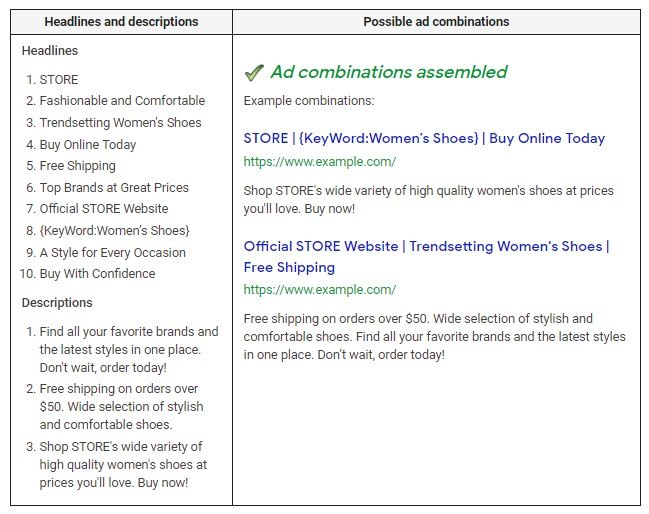
Image source: Supermetrics
Responsive Search Ads vs. Dynamic Search Ads
Responsive search ads and dynamic search ads are both flexible ad formats that tailor the headline and description to the search and the user.
Where they differ is in how they source content for the ad.
With a responsive search ad, the advertiser provides Google with different options for headlines and descriptions. Google then mixes and matches combinations from those options to find the right one to display in search results.
Dynamic ads, on the other hand, populate content directly from your website to display in the ad. Google will generate an ad headline and landing page URL based on the search query and the most used titles or phrases on your website. You can also provide Google with two descriptions for your ads.
Dynamic search ads are useful, particularly if you’re an eCommerce brand that wants to tailor the ad to the exact search query that a shopper is searching for. However, you don’t have full control over the message that’s displayed, which can lead to some mismatches between the dynamically generated portion of the ad and the rest of your messaging.
Responsive search ads give you the flexibility of dynamic ads, with the added benefit of having more control over your messaging.
Responsive Search Ads are replacing Expanded Text Ads in Google Ads
As we touched on earlier, responsive search ads are now the default format in Google Ads — and from 30 June 2022, advertisers will no longer be able to create expanded text ads or edit expanded text ads campaigns.
Here’s Google’s announcement:
Responsive search ads…combine your creativity with the power of machine learning to help you show more relevant ads to more people. Starting 30 June 2022, responsive search ads will be the only Search ad type that can be created or edited in standard Search campaigns. This change will help simplify the way that you create Search ads and make it easier for you to drive performance with our automated tools.
The good news is that any existing expanded text ads you have will still serve in search results. You’ll also be able to pause or resume these Google Ads campaigns, remove them, and access your ad’s performance reports.
Advantages of Responsive Search Ads
Responsive search ads have a few advantages compared to other formats, such as expanded text ads or dynamic search ads.
Here are four of the biggest benefits that responsive ads bring to your PPC campaign:
1. Higher clickthrough and conversion rates
At the heart of it, the goal of every Google Ads campaign is to drive qualified traffic to your website.
According to Google, a responsive search ad is the most effective way to do it.
Google itself has said that advertisers who add responsive ads to their ad groups achieve up to 10% more clicks and conversions. In some cases, this figure has been as high as a 71% increase in revenue and 61% more conversions compared to ETAs.
2. Better personalisation
Personalisation is one of the best ways to increase relevance with potential customers and encourage them to click on your ad.
Consider this stat:
88% of marketers have seen measurable improvements thanks to personalisation. Of these, more than half reported a lift greater than 10%.
With responsive search ads, Google will personalise your ad campaign for the searcher based on their individual behaviour, search intent, device, search history, and more. Plus, you can tailor your ads to a user’s location for an added level of personalisation.
Put this all together, and you have a powerful recipe for clicks and conversions.
3. Built-in A/B testing
If you want to optimise your Google Ads campaigns, you need to A/B test. This is one of the biggest benefits of responsive search ads because the testing feature is built right into every campaign.
Google automatically tests different messaging combinations and adapts your ads based on objectives such as impressions, clicks, and click-through rate. Not only does it mean you’ll save a ton of time on analysing the numbers, but it also means better performance because Google is constantly optimizing in the background (as opposed to humans reviewing ads once a day or once a week).
4. Reach more audiences
With traditional ETAs, advertisers typically have to develop multiple ads to display for searchers based on their search queries, locations, or other factors. Unfortunately, each of these individual ads might only show up for a handful of queries because they’re targeting low-volume keywords.
Responsive search ads have more headlines and descriptions, which means your ad will compete in more auctions and match more search queries. Over time, this means more eyeballs on your ads, as well as more clicks to your site.
How do I create responsive search ads in Google Ads?
Now that we’ve covered the benefits of RSAs, let’s jump into the next part: how to create a new responsive search ad campaign in Google.
Thankfully, this process is fairly straightforward.
First, sign into your Google Ads account and navigate to the main page of your ad campaign. Navigate to the “Ads & extensions” section, select the plus icon, and select “Responsive search ad”:
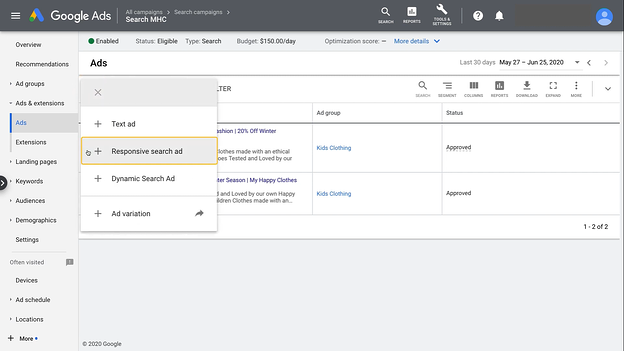
Image source: Knorex
From here, choose the ad group you want to add responsive search ads to. You’ll then be presented with a page where you can input the following responsive search ads specs:
- The final URL, which is the landing page you want people to land on after clicking on the ad
- Your display URL, which is the link that appears to searchers in Google search results
- Up to 15 headlines for your ad
- Up to four descriptions for your ad
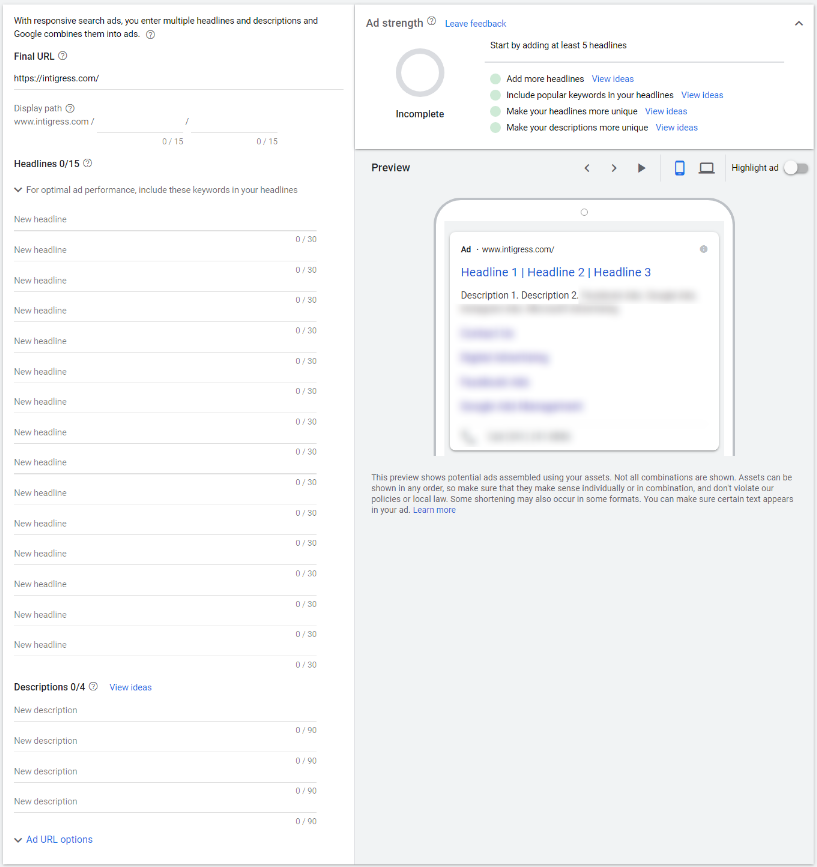
Image source: Intigress
After you’ve filled in all the required sections, Google will provide you with a preview of your ad and your ad strength score. You’ll also get recommendations with tips to improve and optimize your ads:

How can you improve your responsive search ads performance?
Responsive search ads are constantly testing and self-optimising by design. But that doesn’t mean you can’t put your ads in the best position possible to achieve maximum results, or tweak your existing ads to improve campaign performance.
Here are three actions you can take to increase ready-to-buy clicks on your responsive ads:
Utilise all the headlines and descriptions
You have the option to add up to 15 headlines and 4 descriptions. And if you want to optimize your RSA campaigns, you should be creating as many unique headlines as possible.
Here’s Google’s advice:
The more headlines and descriptions you enter, the more opportunities Google Ads has to serve ads that more closely match your potential customers’ search queries, which can improve your ad performance.
This is an opportunity to experiment with messaging to see what resonates with your customers, so make sure to craft multiple headlines and descriptions for your campaigns. This includes:
- Switching up the description to see which selling points resonate with your customers, such as free shipping or fast delivery
- Using different header lengths to see if users prefer short or long headlines
- Avoiding redundant words or filler words in your ad text
- Highlight any unique points that differentiate your business from competing advertisers, such as your product rating, quality, or any value-add services
Another tip? Try to avoid doubling up the same word in different headline variations as well. For example, if you’re writing an ad about activewear, you might choose to write “gym wear” in one headline and “activewear” in another.
Craft a compelling call-to-action (CTA)
Regardless of whether you’re building ETAs or RSAs, you need to have a powerful CTA.
Acronyms aside, your CTA tells your customers what you want them to do and invites them to take action. These should feature in your headline and your description, like this one from Uber Eats inviting people to “order delivery now”:

Adapt your ads to different screens
Google allows you to specify the width of your ads for different screens — and if you’re serious about performance, you should absolutely be doing this for all of your responsive ads.
More than 50% of PPC ad clicks come from mobile. If you’re not adapting your ad copy for mobile, your ads aren’t optimized for half of your audience.
Create different ads that can adapt to varying device widths, including desktop and mobile. This gives Google more flexibility to display shorter headlines on mobile and share a longer message with desktop audiences.

Image source: WebFX
Tips and best practices for Google Responsive Search Ads
Make the most out of pins
Pins are a great way to guarantee that certain messages appear in specific positions on the ad. This gives you more control over the types of combinations Google can make, in order to ensure your ad always makes sense.
Let’s say you create an online advertising headline with a CTA. You want this to appear in search results, but it wouldn’t make sense if it showed up next to another headline that’s also a CTA. In this instance, you can ‘pin’ both of these to the second headline position so they appear in the right place and don’t show up next to one-another.
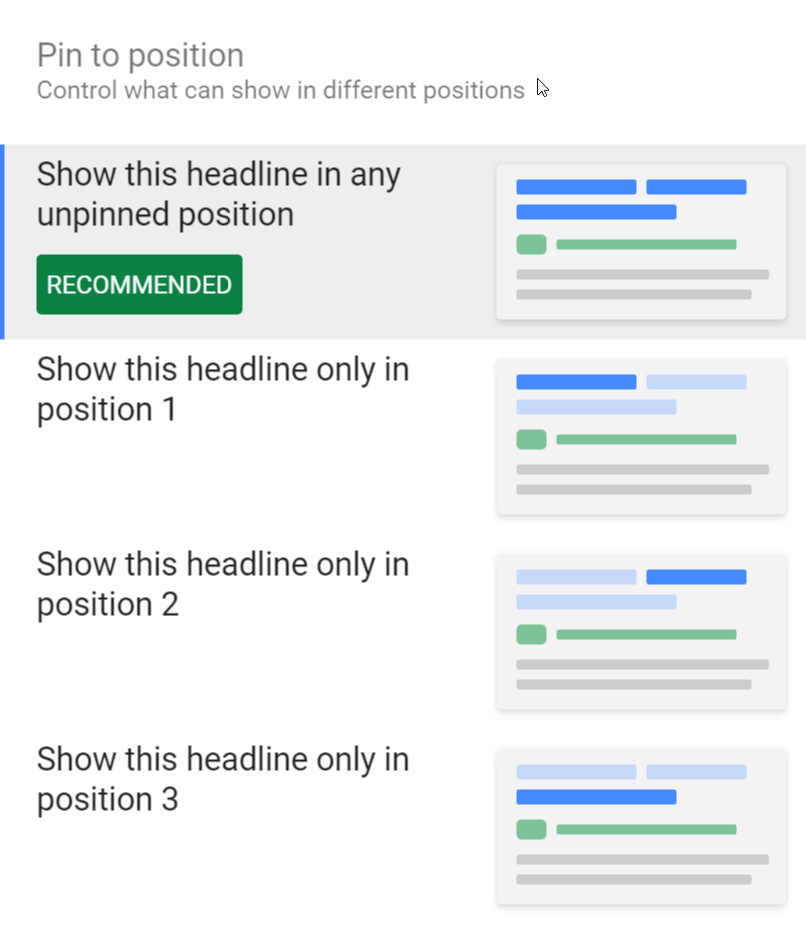
Image source: StoreYa
Keep in mind though that you should only pin headlines and descriptions strategically. Every pin you use restricts Google’s opportunity to test copy combinations to find out which ones are the most effective for your audience.
Create effective ads using existing high-performing ads
Google uses machine learning to automate the testing and optimisation process, but that doesn’t mean you can’t start off with an advantage.
Look at your existing text ads in the same ad group to see which ads are your top performers. Use these as the foundation of your ad headlines and descriptions for your new responsive search ads.
Include top-performing keywords in your headline
Improve the relevance of your responsive search ads by incorporating popular keywords directly into your headline. Google bolds any keywords that are featured in both the search query and your headline or description, which signals to your audience that the ad matches what they’re looking for:
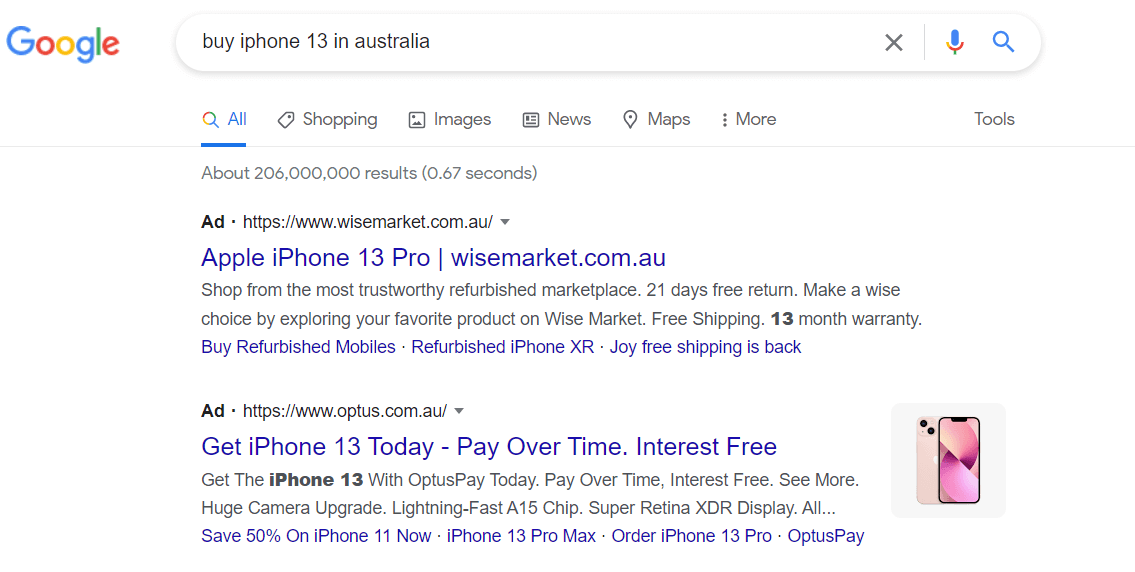
For best results, limit your keyword choice to roughly two or three phrases with the highest search volume. This will also help you improve your overall campaign ad strength.
Ensure your copy variations make sense when put together
Headlines and descriptions can be shown in any order (unless you pin them).
This gives Google a ton of flexibility when displaying different combinations, but it also means you need to pay extra attention to your copy variations.
Imagine if someone types in a search phrase for “hire a carpenter in Sydney” only to see a Google ad that says:
Hire a carpenter Sydney | Carpenter for hire – book now | Book a Sydney carpenter now!
Sure, the ad technically makes sense. But it’s definitely not the best combination because all of the headlines are similar. That’s why you need to write headlines and descriptions that are versatile enough to stand alone, and also make sense when put together.
Start out by highlighting different benefits in your headlines to add variety. For example, if you’re a carpenter, you might choose to have the following headlines:
- Hire a carpenter in Sydney
- 5-star carpenters from $65 p/h
- Top-reviewed Sydney carpenters
This type of approach gives Google’s AI more freedom to experiment with responsive search ads to see which messaging works best for different audiences.
Pay attention to ad strength
When you’re crafting your headline and description variations, make sure to keep an eye on your ad strength and try to achieve a score of Good or Excellent. According to Google, improving your ad strength from Poor to Excellent can increase clicks and conversions by an average of 9%.
If you have a “Poor” ad, follow Google’s ad recommendations to boost up your score before setting your campaign live. Once it’s running, check the asset report to see which headlines and descriptions are underperforming, and replace them with new variations.
Capture ready-to-buy customers with responsive search ads
Responsive search ads are the new default in Google Ads. If you get started with RSA campaigns today and implement these best practices, you’ll be on the front foot when Google officially sunsets ETAs at the end of June.
Not sure how to make the transition from expanded text ads to responsive search ads? Don’t worry — our PPC Gurus are. We’ll help you get the most out of your responsive search ad campaigns so you’re maximising clicks and conversions from Google Ads. Contact us today to request your free audit and 6-month game plan.



